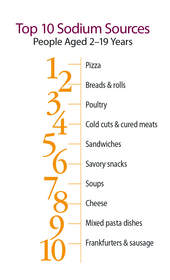MISSION, KS--(Marketwired - Aug 15, 2013) - (Family Features) They need to be able to eat it in 20 minutes or less. They need to be able to open and close all of the containers themselves. And it can't go bad before they eat it. What are we talking about? The lunch your kids take to school each day.
What you put in your child's lunchbox might matter more than you realize. A recent study by the Centers for Disease Control and Prevention found a significant amount of sodium in the foods toddlers commonly eat. It's feared that similar levels of sodium are also found in a number of the foods older kids eat at school every day. As concerns rise about the early onset of high blood pressure, a major risk factor for heart disease, parents may want to re-examine those lunchbox choices.
Why does sodium matter? A 2012 study of children and adolescents found that higher sodium consumption was associated with increased blood pressure. This effect was even greater in overweight and obese participants compared to normal weight participants.
In addition, research suggests that children's taste for salt develops as they are exposed to it. The less sodium children consume, the less they want it. Children's taste for salt may be reduced if they are exposed to lower sodium diets at a young age. Eating less sodium can help lower blood pressure during childhood, which can help lower the risk of high blood pressure as an adult.
What's a parent to do?
Here are some tips to help tackle high sodium in your child's lunchbox:
- Read food labels and compare the sodium amount in different products, then choose the options with the lowest amounts of sodium. Some varieties of bread can vary from 80 to 230 mg of sodium per slice. That can make a big difference in lunchtime sandwiches.
- Pack fresh fruits and vegetables with lunch every day, like a small bag of baby carrots, snow peas, or grape tomatoes.
- For a healthy snack, make trail mix using unsalted nuts, dried fruits and whole grain cereal.
- When buying prepared meals, look for those with less than 600mg of sodium per serving.
By packing a lower sodium school lunch for your children, you are not only setting them up for success in the classroom, but also in life. With your help, your children can develop healthy, low sodium eating habits that will last throughout their lives and help improve their heart health. For additional information about children and sodium and more tips for parents to help lower their family's sodium intake, visit www.cdc.gov/salt.
Where's the sodium?
Understanding sodium in foods can be confusing, especially when food that otherwise seems healthy may have high levels of sodium. Most of the sodium we eat doesn't come from the salt shaker, but is found in processed and restaurant foods. This chart shows the Top 10 Sodium Sources for children and adolescents. How many of these have made an appearance in your child's lunchbox?
Make-Your-Own Snack Mix
Get your kids involved in making this healthy snack mix.
| Prep time: 5 minutes | ||
| Cook time: 0 minutes | ||
| Yields: 4 servings | ||
| Serving size: 1/2 cup snack mix | ||
| 1 | cup toasted oat cereal | |
| 1/4 | cup unsalted dry roasted peanuts (or other unsalted nut) | |
| 1/4 | cup raisins | |
| 1/4 | cup dried cranberries | |
Combine all ingredients, and toss well.
Serve immediately, or store for later snacking.
Tip: Put snack mix in individual snack-sized bags for a great grab-and-go snack.
Recipe from the National Heart, Lung, and Blood Institute, part of the National Institutes of Health
About Family Features Editorial Syndicate
This and other food and lifestyle content can be found at www.editors.familyfeatures.com. Family Features is a leading provider of free food and lifestyle content for use in print and online publications. Register with no obligation to access a variety of formatted and unformatted features, accompanying photos, and automatically updating Web content solutions.
Contact Information:
Vickie Rocco
vrocco@familyfeatures.com
1-888-824-3337
http://editors.familyfeatures.com
